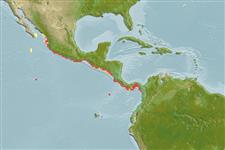>
Blenniiformes (Blennies) >
Chaenopsidae (Pike-, tube- and flagblennies)
Etymology: Acanthemblemaria: Greek, akantha = thorn + Greek, emblema, -atos, anything that is nailed, knocked in; also anything with bass or high relief (Ref. 45335).
Eponymy: Captain George Allan Hancock (1875–1965) was an oil magnate, banker, businessman and philanthropist. [...] (Ref. 128868), visit book page.
More on authors: Myers & Reid.
Environment: milieu / climate zone / depth range / distribution range
Οικολογία
Θαλασσινό(ά) Υφαλόφιλο(α); εύρος βάθους 1 - 5 m (Ref. 11482). Tropical; 24°N - 5°N, 113°W - 76°W (Ref. 56269)
Eastern Central Pacific: Costa Rica and Panama.
Μέγεθος / Βάρος / Age
Maturity: Lm ? range ? - ? cm
Max length : 4.5 cm TL αρσενικό/απροσδιόριστο; (Ref. 11482)
Inhabits empty worm and tube mollusk tubes on rocky reefs. Feeds on zooplankton.
Life cycle and mating behavior
Γεννητική Ωρίμανση | Αναπαραγωγή | Γεννοβολία | Αβγά | Γονιμότητα | Προνύμφες
Allen, G.R. and D.R. Robertson, 1994. Fishes of the tropical eastern Pacific. University of Hawaii Press, Honolulu. 332 p. (Ref. 11482)
IUCN Red List Status (Ref. 130435: Version 2024-2)
Threat to humans
Harmless
Human uses
Εργαλεία
Special reports
Download XML
Διαδικτυακές πηγές
Estimates based on models
Preferred temperature (Ref.
123201): 26.9 - 29.1, mean 28.2 °C (based on 113 cells).
Phylogenetic diversity index (Ref.
82804): PD
50 = 0.5000 [Uniqueness, from 0.5 = low to 2.0 = high].
Bayesian length-weight: a=0.00525 (0.00219 - 0.01260), b=3.06 (2.85 - 3.27), in cm total length, based on LWR estimates for this (Sub)family-body shape (Ref.
93245).
Τροφικό Επίπεδο (Ref.
69278): 3.4 ±0.45 se; based on food items.
Fishing Vulnerability (Ref.
59153): Low vulnerability (10 of 100).
Nutrients (Ref.
124155): Calcium = 216 [102, 449] mg/100g; Iron = 0.954 [0.507, 1.746] mg/100g; Protein = 18 [17, 19] %; Omega3 = 0.0951 [, ] g/100g; Selenium = 13.2 [5.4, 35.0] μg/100g; VitaminA = 434 [120, 1,569] μg/100g; Zinc = 2.46 [1.51, 3.86] mg/100g (wet weight);
